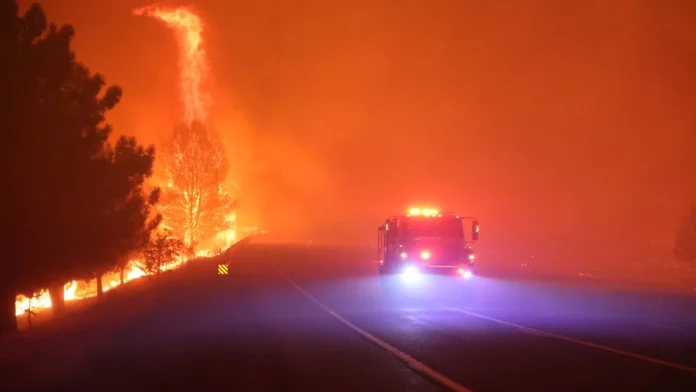Written By Lisa Murimi
An enormous wildfire, known as the Park Fire, has grown at a staggering rate of 8 square miles (20 sq km) per hour as it ravages parts of northern California.
Originating on Wednesday from a suspected arson attack, the blaze has consumed over 350,000 acres north-east of Chico and is only 10% contained, according to Cal Fire.
Approximately 3,700 firefighters are battling the inferno, which is fueled by steep terrain and wind gusts.
The fire, now the largest in the state this year and the seventh largest ever recorded in California, has already burned an area more than 1.5 times the size of New York City’s five boroughs.
Authorities have arrested a 42-year-old man, suspected of starting the fire by rolling a burning car into a gully near Alligator Hole in Butte County.
Fire captain Robert Foxworthy explained that the challenging terrain and limited road access have complicated efforts to combat the fire. The blaze is exacerbated by embers igniting spot fires far ahead of the main front.
Cal Fire incident commander Billy See noted that the fire is spreading at a rate of 5,000 acres per hour, despite nearly tripling the firefighting personnel.
Governor Gavin Newsom declared a state of emergency in Butte and Tehama counties and announced federal assistance for the affected areas. Despite improved weather conditions, with lower temperatures and higher humidity, the fire continues to grow in some regions.
Mandatory evacuations have been ordered in Butte County, including the town of Cohasset. Cal Fire reported that 134 structures have been destroyed, and 4,200 remain threatened.
Ronnie Dean Stout, 42, was arrested and accused of starting the fire. He is being held without bail while charges are determined. The Park Fire is among many large fires burning across the US and Canada, with the National Interagency Fire Center monitoring 102 active fires in the US alone.
In related news, a firefighting pilot died in a tanker plane crash in Oregon, and a wildfire in Jasper National Park, Canada, destroyed hundreds of buildings. Improved weather conditions in Jasper have aided efforts to protect the historic town.



















